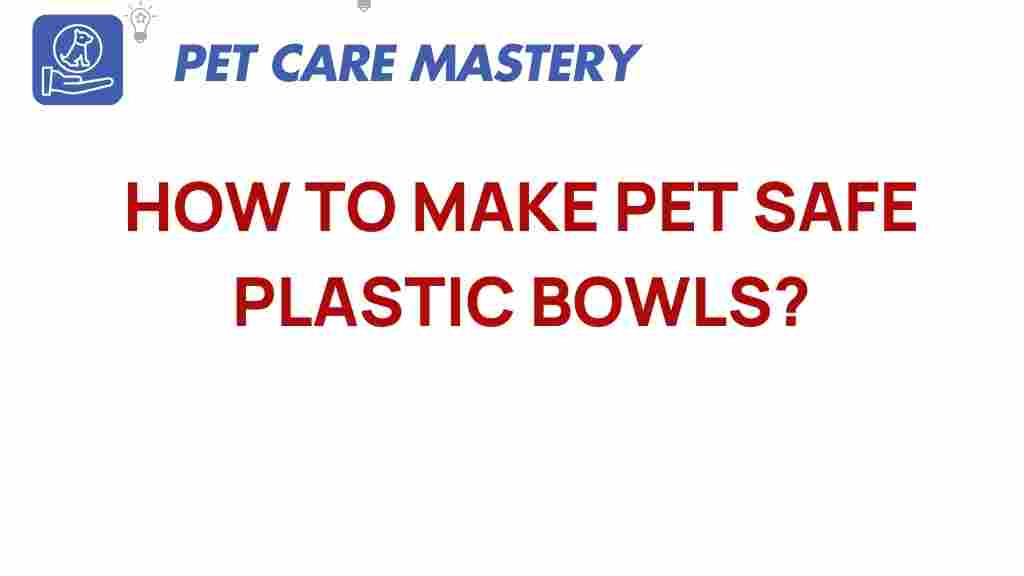The Secret to Crafting Pet-Safe Plastic Bowls at Home
When it comes to caring for our beloved pets, ensuring their safety is paramount. One often-overlooked aspect of pet safety lies in the materials used for feeding. Many commercial plastic bowls contain harmful chemicals that can leach into food and water, posing potential health risks to our furry friends. In this article, we will explore how to craft pet-safe plastic bowls at home, allowing you to provide a safe and comfortable dining experience for your pets.
Understanding Pet-Safe Materials
Before diving into the crafting process, it’s essential to know what makes a plastic bowl pet-safe. Here are some key points to consider:
- BPA-Free: Bisphenol A (BPA) is a chemical often found in plastics that can disrupt hormones and affect health. Always choose BPA-free materials.
- Food-Grade Plastic: Ensure the plastic you choose is labeled as food-grade, which signifies it is safe for food contact.
- No Phthalates: These chemicals are used to make plastic more flexible. Avoid plastics that contain phthalates as they can be harmful to pets.
Materials Needed
To create your own pet-safe plastic bowls, gather the following materials:
- Food-grade plastic sheets or containers
- Scissors or a utility knife
- Sandpaper (fine grit)
- Non-toxic, water-based adhesive
- Paint or sealant (optional, for decoration)
Step-by-Step Process to Craft Pet-Safe Plastic Bowls
Now that you have your materials ready, let’s go through the process step by step.
Step 1: Choose the Right Design
Decide on the design and size of the bowl you want to create. Consider your pet’s size and eating habits. A shallow bowl may work for cats, while a deeper bowl is suitable for larger dogs.
Step 2: Cut the Plastic
Using scissors or a utility knife, carefully cut the food-grade plastic into the desired shape. A circular shape is common for bowls, but feel free to get creative!
Step 3: Smooth the Edges
After cutting, the edges may be sharp. Use fine-grit sandpaper to smooth out any rough edges. This step is crucial to prevent any potential injury to your pet while eating.
Step 4: Assemble the Bowl
If you are creating a multi-layer bowl or adding a base, apply a non-toxic, water-based adhesive according to the manufacturer’s instructions. Allow it to dry completely before proceeding.
Step 5: Decorate (Optional)
If you want to personalize your bowl, consider using non-toxic paint or sealant. Ensure that any materials used are pet-safe and allow adequate drying time before introducing the bowl to your pet.
Testing for Safety
Before using your new pet-safe plastic bowl, conduct a safety test:
- Pour water into the bowl and let it sit for 24 hours.
- Check for any discoloration or unusual smells.
- If everything seems fine, rinse the bowl thoroughly before use.
Troubleshooting Tips
While crafting your pet-safe bowls, you may run into some challenges. Here are some troubleshooting tips to help you:
- Bowls Are Not Sturdy: If the bowls feel flimsy, consider adding a heavier base or using thicker plastic.
- Edging Is Sharp: If the edges are still sharp after sanding, repeat the sanding process until smooth.
- Adhesive Not Holding: Ensure you are using a non-toxic adhesive suitable for plastic. If it fails, reapply and allow extra drying time.
Benefits of Making Your Own Pet-Safe Bowls
Creating your own pet-safe plastic bowls comes with numerous advantages:
- Cost-Effective: Making bowls at home is usually cheaper than buying specialized pet products.
- Customization: You can design bowls tailored to your pet’s needs and preferences.
- Eco-Friendly: Using recycled plastic or upcycling old containers contributes to environmental sustainability.
Conclusion
Crafting your own pet-safe plastic bowls at home is not only a rewarding project but also a practical way to ensure your pet’s safety. By understanding the materials and following the steps outlined in this article, you can create bowls that are both functional and stylish. Remember to always prioritize your pet’s health and safety by opting for non-toxic, food-grade materials. For more tips on pet care and DIY projects, check out our other articles here. For more information on safe materials, you can visit this resource.
This article is in the category Products and created by PetCareMastery Team
